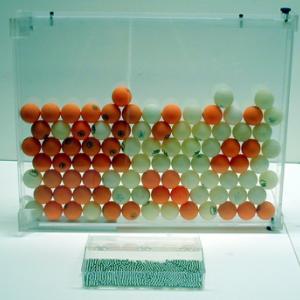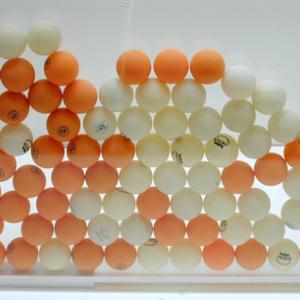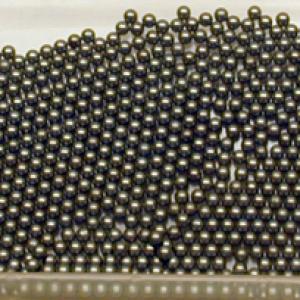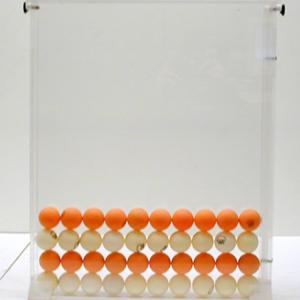College of Liberal Arts & Sciences
1R50.40 - Faults in a Crystal
Add the desired amount of ping-pong balls and arrange in an ordered fashion. Turn upside down of shake. Faults will be readily apparent.
Another twist is to use different colored ping-pong balls arranged in an ordered structure. Turn upside down or shake to show random crystal formation.
- Wallace A. Hilton, "Imperfections in Crystals", TPT, Vol. 8, # 6, Sept. 1970, p. 335.
- S. A. Knaack, M. Redden, and M. Onellion, "AAO Nanopore Arrays: A Practical Entree to Nanostructures", AJP, Vol. 72, # 7, July 2004, p. 856.
- W. H. Tantilla, J. Cooper, and D. J. Toms, "Demonstration of Possible Excitations in Liquids", AJP, Vol. 45, # 4, Apr. 1977, p. 395.
- D. A. Kiewit, "A Simple Demonstration of the Pinning of Deformation Fronts", AJP, Vol. 40, #4, April 1972, p. 618.
- Edward N. Sickafus, "Stacking-Fault Model fcc-hcp Unit-Cell Transformation", AJP, Vol. 34, #11, Nov. 1966, p. 1064.
- Ma- 5, Freier and Anderson, A Demonstration Handbook for Physics.
- S- 200, "Tennis Balls & Ball Bearings", DICK and RAE Physics Demo Notebook.
- Mark Wilson, "Nanoscale Ordering From Bulk Processing", Physics Today, May 2014, p. 15.
- W. T. M. Irvine et al., "Taming Topological Defects with Light", Physics Today, Nov. 2013, p. 17.
- N. Gravish, et. al, "Plowing Through a Granular Medium", Physics Today, October 2010, p. 22.
- Steven K. Blau, "A Novel Composite is Stiffer Than Diamond", Physics Today, April 2007, p. 18.
- Back Scatter, "Diamonds from the deep", Physics Today, February 2017, p. 80.
- Yaakov Kraftmakher, "5.1, Equilibrium Point Defects in Metals", Experiments and Demonstrations in Physics, ISBN 981-256-602-3, p. 289.
- Alan Holden and Phylis Morrison, "Solids and Crystals", Crystals and Crystal Growing, p. 32- 37, and Plate 29.
- "Models of Matter", Physics From the Junk Drawer, 3rd Edition, The Science House, North Carolina State University, p. 10.
- W. Bolton, "Dislocation Model", Book I - Properties of Materials, Physics Experiments and Projects, 1968, p. 4.
- Borislaw Bilash II, “Metallic Bonding“, A Demo A Day – A Year of Physical Science Demonstrations, p. 126.
Disclaimer: These demonstrations are provided only for illustrative use by persons affiliated with The University of Iowa and only under the direction of a trained instructor or physicist. The University of Iowa is not responsible for demonstrations performed by those using their own equipment or who choose to use this reference material for their own purpose. The demonstrations included here are within the public domain and can be found in materials contained in libraries, bookstores, and through electronic sources. Performing all or any portion of any of these demonstrations, with or without revisions not depicted here entails inherent risks. These risks include, without limitation, bodily injury (and possibly death), including risks to health that may be temporary or permanent and that may exacerbate a pre-existing medical condition; and property loss or damage. Anyone performing any part of these demonstrations, even with revisions, knowingly and voluntarily assumes all risks associated with them.



